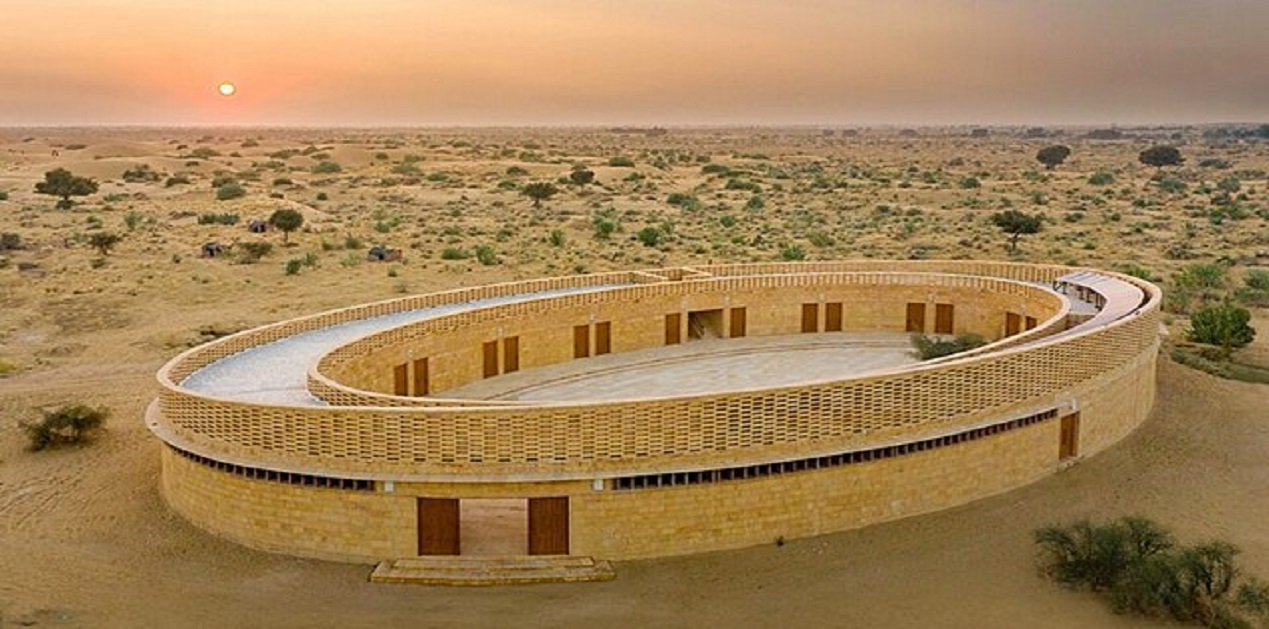In the heart of Jaisalmer, known as the “Golden City” for its remarkable yellow sandstone architecture, lies a revolutionary educational and architectural marvel. The Rajkumari Ratnavati Girls’ School stands as a testament to the fusion of visionary design and transformative education, offering hope and inspiration far beyond its geographical boundaries. More than a mere school, it symbolizes the potential of innovation, sustainability, and the relentless pursuit of knowledge.
Commissioned by the US non-profit organization CITTA, it encompasses a women’s cooperative centre and an exhibition hub. The land for the school was donated by the royal family of Jaisalmer and Manvendra Singh Shekhawat. Its distinction is undeniable and was named the 2020 “Building of the Year” by Architectural Digest India. The eco-friendly sandstone school commenced operations in June 2023 after almost a year’s delay due to the pandemic. It started with the enrolment of 120 girls from classes 1 to 4 into its curriculum. It can accommodate 400 students and aims to go up to Class 10 level eventually. This architectural venture, orchestrated by Diana Kellogg Architects, stands as a bold departure from convention, led by a vision that seeks to harmonize contemporary design with the wisdom of traditional Jaisalmer architecture.
Crafted against the backdrop of scorching temperatures that can scale a staggering 49 degrees Celsius during the peak of summer, this institution defies convention. The ingenuity of this school transcends its mission; it finds its roots in the very structure it’s built upon, paying homage to local craftsmanship and ecological mindfulness. The architectural wonder lies in its ability to combat extreme temperatures naturally. The secret lies in its oval shape and its integration of sustainable architectural principles. This distinctive structure exploits the aerodynamics of its form to facilitate natural ventilation, allowing hot desert air to circulate efficiently, thus mitigating heat absorption. This effect is augmented by the strategic use of locally sourced, heat-reflective construction materials and well-positioned shading mechanisms that ensure comfort during the unforgiving summer months.
But this school is more than a shelter from the scorching sun; it is a testament to renewable energy. Powered by solar panels and wind turbines, the institution harnesses the region’s renewable resources, storing energy through advanced battery systems for continuous power supply. This self-sufficiency model not only reduces operational costs but also showcases an exemplary model of sustainable education, setting a potent precedent for the future.
The Rajkumari Ratnavati Girls’ School champions climate consciousness, gender equality, and the boundless potential of architecture to shape transformative educational environments. This visionary endeavour goes beyond the confines of its walls, radiating positive influence through the community and beyond. Every brick of its oval frame echoes tales of resilience and progress. In reimagining the concept of a learning space, it defies conventional norms and underscores the harmony that can exist between environment, culture, and inclusivity. As the global community confronts pressing environmental issues and social disparities, the Rajkumari Ratnavati Girls’ School illuminates a forward path. It isn’t just a school but a blueprint for the evolution of educational institutions, an embodiment of how education and architecture can synergistically pave the way to a sustainable, equitable future.
(The paper is the author’s individual scholastic articulation. The author certifies that the article/paper is original in content, unpublished and it has not been submitted for publication/web upload elsewhere, and that the facts and figures quoted are duly referenced, as needed, and are believed to be correct). (The paper does not necessarily represent the organisational stance... More >>
Image Source: https://upload.wikimedia.org/wikipedia/commons/thumb/5/51/Rajkumari_ratnavati_girls_school.jpg/640px-Rajkumari_ratnavati_girls_school.jpg











Post new comment